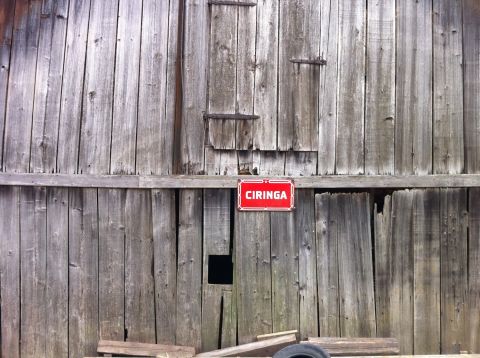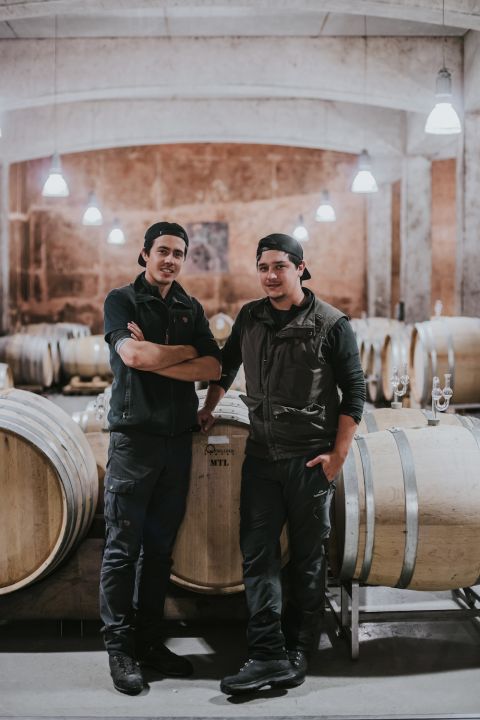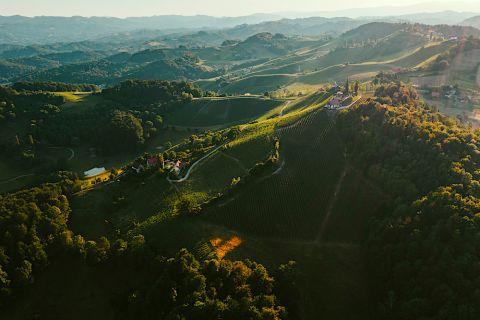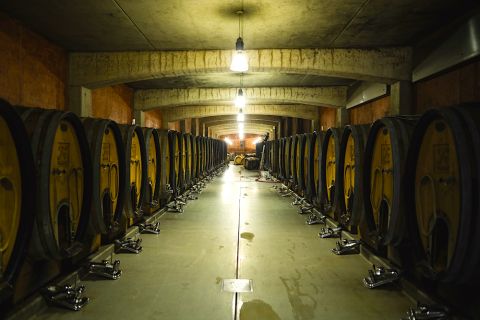From €9.90, $17.99, 149.95 Danish kroner, £18.99
The rain was coming down so heavily that at times it was difficult to see the road as we cut north through the wide, flat valley; through luminous-green swathes of baby wheat and buckwheat and corn; through fields of what may have been potatoes or pumpkins, spearing brave new leaves through thick, rich soil, in immaculate rows. As the downpour eased and the car started to climb into the mountains, mist threaded through the tall forest trees. Everything was so green. So intensely green and lush and verdant that it felt almost like a rainforest.
It was early May 2023. We were right on the border of Austria and Slovenia, in Styria. One of the wettest wine regions in the world. A region that has become, in recent years, famous for Sauvignon Blanc. Wines that are nothing like their counterparts from New Zealand, the Loire or Bordeaux, but are instead, as Paula Sidore describes it, ‘existing at the corner of Alpine agility and Pannonian pure’. The top wine producers in this area are making some of the most ageworthy Sauvignons in the world.
What most people don’t know is that the Sauvignon Blanc from the Slovenian Styria – Štajerska – is just as unique and every single bit as good as that from Austria’s Südsteiermark, and half the price. A clear case in point: Domaine Ciringa.
Domaine Ciringa (pronounced Tsee-ring-ga; it’s the Slovenian name for the Zieregg vineyard) belongs to the Tement family of Austrian Sauvignon fame. When we arrived at the domaine, Armin Tement piled us into his electric SUV and drove us along winding roads, thick forests giving way to sweeping views of their steep amphitheatre of vineyards, the line between their Štajerska Slovenija vineyards and their famous Südsteiermark vineyards entirely invisible.
He explained that his father, Manfred (who is still actively involved in the business), was farming just a few hectares of vineyards in the early 2000s, and could see that the abandoned Slovenian vineyards adjoining his were exactly the same terroir. After Slovenia entered the EU in 2004, Tement began buying vineyards just across the border, piecing together dozens of tiny plots. He had to track down more than 30 owners, none of whom was working the vineyards; many had left the country; some had died and no one knew of surviving relatives.
Today the Tements farm 20 ha (49 acres) of organically and biodynamically farmed vineyards in Štajerska that are every bit as superlative as their Austrian counterparts.
Although EU regulations make it nigh-on impossible to make appellation-status wine from grapes grown in one appellation and vinified in another appellation, let alone country, Armin and his brother, Stefan, have managed to get permission to drive their Slovenian grapes a couple of hundred metres up the road to be fermented in their Austrian winery, and have the finished wines retain Štajerska appellation status. The family has to re-apply for this permission every year, and it is strictly controlled and overseen (every kilogram of grapes must be weighed at picking and accounted for on arrival at the winery; every drop of wine must be kept separate from the Austrian production). The paperwork is not for the faint-hearted.
As we headed back over the border to taste the wines, Tement explained that the Ciringa wines are made in the same way as the Austrian wines, too: spontaneous ferments, lees ageing, little to no sulphites added, and only just before bottling. Old, big oak barrels are nearly always a part of the winemaking as is natural malolactic conversion. (They do not filter the wines, so it’s safer for the wines to go through malo ‘and get all their stuff over and done with’, Tement says.) They work oxidatively in the beginning of the vinification: ‘It means the wines go brown, start very open, and then develop more shape.’ The wines also usually spend 5–12 hours on their skins before pressing.
I admit that when I sat down to taste the wines in Tement’s hyper-sleek, modernist Austrian winery, with its soaring glass windows looking over the Zieregg vineyard, I began feeling consciously defensive. Everything about this place is extremely, and I mean extremely, well designed. I feared the wines would be similar – and those are the sort of wines I like the least.
But as I tasted – three flights, six vintages, all Sauvignon Blanc from their Slovenian vineyards, narrowing down from village to reserve to single parcel – I was undone. These are wines with the vivid colours of Frida Kahlo, the smoky slow of Diana Krall, the rhythmic spaces of Kathleen Jamie.
If I could have, I would have chosen Domaine Ciringa’s entire range as my wine of the week. But forced to choose, I’ve picked the wine that represents the whole domaine’s terroir – vines growing across the vineyard area on soils so young that you can still find fossils of anemone-like shells so big I needed both hands to hold just one. The Fosilni Breg (‘fossil hill’ in Slovenian) is like sucking on a light-splitting prism of fruit and acidity and stones and soil and mountains and leaf. It tells its own story. It’s vibrant, complex, but also utterly unpretentious and so delicious and somehow wholesome that I found myself wondering for a second if one could use this as a blood infusion for world-weary souls.
All this for less than 13% alcohol and less than $20/£20. Not only that, but we tasted back to vintage 2015, and believe me, this wine must have a Dorian Gray portrait tucked into the back of that mountain cellar somewhere, ageing on its behalf.
I’ve not highlighted a vintage because every vintage on the market today is drinking beautifully. The wine can be found in Austria, Denmark, Germany, Ireland, Luxembourg, the Netherlands and in the US, where it’s imported by Skurnik Wines. In the UK, it’s imported by Novel Wines and sold retail by 9 Elms Wines, The Wine Twit, Blanco & Gomez and via Amazon.
For more on Slovenian wine, see Tam’s earlier articles, as well as our tasting-note database.
All photos are kindly provided by the Tement family.


















